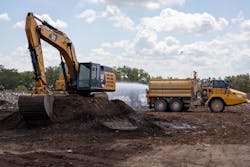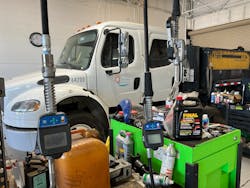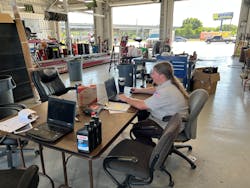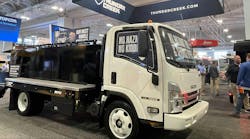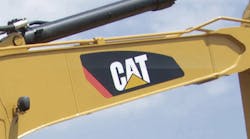The world has changed in the three years since Matt Case, CEM, and his team at Manatee County (Florida) Government Fleet last won the Fleet Masters award in 2020.
First, there was a worldwide pandemic, followed by economic and supply chain chaos. As a result, what worked when Manatee won in 2020 had to be thoroughly examined and adjusted for the not-so-brave new world of 2023.
Manatee County won the Construction Equipment and AEMP Fleet Masters title again this year (the fifth overall for the county) despite challenges in acquisition, the parts supply chain, and the labor market.
“One of the biggest things we had to do was to be more fluid with the changing environment of equipment acquisition and the problem of hiring and retaining staff,” Case says. “We had to look at our training program, we had to look at our pay grades, but the biggest part for us was the finance side and the acquisition side on the equipment.”
With the less-heralded pandemic of "price realization" from the manufacturers, code for multiple increases, that meant asking administrators and elected officials for more money.
“The first thing we did was meet with our county administration team and had discussions with them regarding the changing in pricing and the volatility of the equipment market," Case says. "By doing that, not only did we have to educate them on the constant changing prices, but we also had to gain their trust as to why we’re coming to them and asking for another two-to-five million dollars on an acquisition cycle."
Inflation and the acquisition plan
Case and his team were able to secure the funding because there was already trust in the bank. "We had been dead-on with our five-year replacement projection ever since I took over in 2018. We are right on."
That didn't mean there was no preparation for the meetings.
"I did give them some scenarios," Case says. "A pickup truck bought in '21 versus a pickup truck bought in '22; same exact configuration meant about a 10-percent price difference. Same with equipment. We’ve seen anywhere from 5- to 20-percent price increases on some things. Because of the five-year projection that we already had, they knew we were asking for something we need."
Discussions with the powers that be aren't always so smooth. Case says one of the first comments he heard was about extending lifecycles. Not that simple.
Read also: How to use cost history to determine remaining life
“[I said] we’re already running this equipment as far as we can within its economic lifecycle, but the problem we’ve also found with some equipment is the manufacturers are not supporting it longer term. In the old days, we could run something and get parts seven to 10 years later. Well, now those manufacturers are no longer supporting it that long," Case says. "Now you have a broken piece of equipment, you can’t get parts, and you can’t do the job. So, that was really important to sell to [the board]."
Case has previous experience working in luxury automotive manufacturing where he learned selling new is always the primary goal. "The only reason we fixed equipment is because sales makes the sale, but service brings back the next sale. That is going to be [the construction equipment manufacturers'] business case—selling new equipment. Unfortunately, it’s going to hurt a lot of people who run long lifecycles. Or those who rely on buying old, surplus equipment and refurbishing it."
With these problems, end users working their "equipment triangle" relationships with manufacturers and dealers becomes more important.
"We’ve been good on some very expensive equipment; landfill compactor is a great example," Case says. "We have two in our organization, one is an older 836 that was aging and had already been rebuilt once. We went back to Caterpillar, told them what we were thinking about, and they advised us they were phasing out that model because there just wasn’t enough demand. So we bought a new one.
"Our second one was coming due two years later," Case says. "It was in an age range with a serial number where they are continuing to support it, so we rebuilt that machine."
Read also: When machine rebuilds make sense
That decision saved the county almost $600,000.
"We write the specifications internally, hand it to them, they do their inspections and make sure the frame still looks good," Case says. "We have world-class maintenance, so our machine is good, and they came back with some things we needed to fine tune and actually helped us. That machine is getting ready to go for rebuild now.
"I did catch some heat because I wanted to rebuild it a hair early and not run it to where it was going to be completely worn out," he says. "It’s actually great we did that, because our replacement machine for the first one was delayed almost a year. And you can’t have a compactor not running in our organization. When a compactor is down, that’s like an ambulance that doesn’t run. It's mission critical."
Case says careful examination and planning is seeing the county through the post-pandemic headwinds.
"Planning, planning, planning. That's what it all boils down to," Case says. "You really have to have that business hat on. If you don't, you're basically going to turn into a glorified maintenance shop."
Through all the difficulties, Manatee County has still maintained an impressive 95 percent fleet availability with a 2,000-asset mixed fleet. Even with the supply chain issues, Case's employees have had a minimum 93 percent requirement written into their performance evaluations. That goes for his evaluation, too.
"If we miss that, you do not meet expectations," Case says. "But staff continues to meet that 95 percent. It’s been very tough, and a lot of that is sourcing parts, but a lot of it is continuing to keep the equipment moving in and out. But if you get where your average age is near that average lifecycle, you’re going to be a glorified maintenance shop and half your stuff is going to be broken—and you can’t get parts," he warns.
Keeping equipment running longer is not an automatic answer. The county has a fleet of seven motor graders in a very demanding application.
"We used to run graders nine years," Case says. "Our motor graders are grading shell roads nonstop all day long. Eastern Manatee County is very rural, and it’s an agriculture-based community. Because of availability issues with parts and availability issues with labor, we’ve actually cut those back down to seven years.
"An advantage of that is I’m selling a machine with fewer hours, and yeah, could I run it a little longer? It’s a maybe. And I’ve kept fleet availability up on that equipment over 90 percent, so it’s basically preventive maintenance and cycling them in and out," Case says.
"If you run until fail, that’s a great example; we can’t grade the roads, ambulances can’t run the roads, people can’t get out of their houses. We were hit with a near-category 5 hurricane this year. We look at all that when we calculate the risk worth taking. The machines have to run."
Manatee's fleet includes ambulances, with similar availability issues to yellow iron. Case says purchase order to delivery was generally 12 months, and now they're pushing 24 to 36 months. And mileage and hours are two different things in planning. For Manatee's equipment, particularly on-road, the fleet has come up with a formula to help define age and wear. It balances the city and rural environments to come up with a fair and equal weighing system.
"In our organization, 20,000 hours is equivalent to 600,000 miles," Case says.
How was that decided?
"We did a traffic study, drove one end of the county to the other, and ended up with an average speed of 30 mph. So every equipment hour is equivalent to 30 miles of run time. So if something has 10,000 hours, that's got 300,000 miles on it," Case says.
When an administrator, or anyone, questions why the fleet is looking at replacement for a vehicle with only 75,000 miles on it, Case points out that it has 10,000 hours on it and it may well take him two years to receive a new one. "We have to constantly educate, and you just have to stay on your plan."
The other factor that plays into good maintenance practices is the labor shortage. Retaining technicians has been difficult.
Tough to attract technicians
"For the current staff, we try to keep them as comfortable as possible," Case says. "That means buying them fans, t-shirts, Gatorade, pretty much anything they need to be comfortable and safe. We also have a very liberal vacation policy here. I do not like telling anybody they cannot take a day off. I like to see a minimum of a week of education a year or more, for just about everyone. If someone comes to us and points out a class that fits their career and track, we always approve it."
It has not been as easy to attract the new technicians.
"To attract new talent, we use the same things, but when it boils down to it, it’s money," Case says. "It’s all money. We have been really lucky for a long time here by treating the people well and educating them, but unfortunately I have lost some staff now due to pay. And it’s substantial."
Case has had techs poached by private contractors, who at this point can offer much more cash. "In the last six months now, I’ve lost four technicians to private firms with salaries the county can’t match," Case says. In addition to a substantial raise, private firms are throwing in perks like take-home vehicles and gas cards.
"We’re seeing in our market, an experienced technician, an ASE Master, especially in the field, that’s $50 an hour they’re going to make," Case says.
"Our administration is now aware of it, but I also present to them what it costs to outsource that work," he says. "We already outsource collision work, major in-frame repairs, things that we can’t do quick and fast here. That equates to about five technicians’ worth of work right now that we outsource, which is huge in our organization."
Case wishes he didn't have to.
"You lose control. As an OCD, ADD, alpha fleet manager like we all are, we want control. I want to know every step!”
The county does outsource more now post-pandemic than it historically has, but in-house maintenance still rules the day—and the bottom line.
"We do about 40,000 labor hours out of our shop, and through a labor rate study and for what we charge, we save the county commissioners about $3 million a year just in labor," Case says. "And that doesn’t include the markup in parts. So, we sell parts at cost plus an administrative fee, while you pay list at these vendors. The other thing that’s tough on that is that a lot of people have negotiated rates with vendors.
"I’ve stopped doing that because what I’ve found is the vendor says, 'Oh, they’re only going to pay this per hour, and we’ve got all this other customer pay work, so we’re going to do those [first],'" Case says.
"Now if we get prices and they’re above a certain threshold, we’ll negotiate it down. That’s really helped up with the vendors. Until I feel the market has stabilized and the people that make a quarter million dollars a year understand we need to pay technicians better, I think the market it going to suffer and the equipment industry is going to suffer," Case says.
"Where we may see some blessing is the more electric equipment that comes online requires less maintenance and repair; I think that’s going to help."
